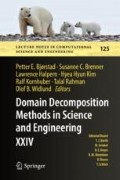Abstract
We review some important ideas in the design and analysis of robust overlapping domain decomposition algorithms for high-contrast multiscale problems.
Access this chapter
Tax calculation will be finalised at checkout
Purchases are for personal use only
Notes
- 1.
Due to the page limitation, only a few references are cited throughout.
- 2.
The coarse mesh does not necessarily resolve all the variations of κ.
- 3.
These works usually assume some alignment between the coefficient heterogeneities and the initial non-overlapping decomposition.
- 4.
We can include constructions of boundary conditions using 1D solution of the problem along the edges. Other choices include basis functions constructed using oversampling regions, energy minimizing partition of unity (global), constructions using limited global information (global), etc.
- 5.
Here we avoid restriction and extension operators for simplicity of notation.
- 6.
We mention that the analysis does not use a stable decomposition so, in principle, a new family of robust methods can be obtained.
- 7.
Having a robust condition number close to 1 is important, especially in applications where the elliptic equation needs to be solved many times.
References
J.E. Aarnes, T. Hou, Multiscale domain decomposition methods for elliptic problems with high aspect ratios. Acta Math. Appl. Sin. Engl. Ser. 18, 63–76 (2002)
V.M. Calo, Y. Efendiev, J. Galvis, G. Li, Randomized oversampling for generalized multiscale finite element methods. Multiscale Model. Simul. 14(1), 482–501 (2016)
E.T. Chung, Y. Efendiev, W.T. Leung, Constraint energy minimizing generalized multiscale finite element method (2017). Arxiv preprint arXiv:1704.03193
M. Dryja, M. Sarkis, O. Widlund, Multilevel Schwarz methods for elliptic problems with discontinuous coefficients in three dimensions. Numer. Math. 72(3), 313–348 (1996)
Y. Efendiev, J. Galvis, P.S. Vassilevski, Multiscale spectral AMGe solvers for high-contrast flow problems. Preprint available at http://isc.tamu.edu/resources/preprints/2012/2012--02.pdf
Y. Efendiev, J. Galvis, P.S. Vassilevski, Spectral element agglomerate algebraic multigrid methods for elliptic problems with high-contrast coefficients, in Domain Decomposition Methods in Science and Engineering XIX. Lecture Notes in Computational Science and Engineering, vol. 78 (Springer, Heidelberg, 2011), pp. 407–414
Y. Efendiev, J. Galvis, T. Hou, Generalized multiscale finite element methods. J. Comput. Phys. 251, 116–135 (2013)
J. Galvis, Y. Efendiev, Domain decomposition preconditioners for multiscale flows in high contrast media. SIAM J. Multiscale Model. Simul. 8, 1461–1483 (2010)
J. Galvis, Y. Efendiev, Domain decomposition preconditioners for multiscale flows in high contrast media. Reduced dimensional coarse spaces. SIAM J. Multiscale Model. Simul. 8, 1621–1644 (2010)
I.G. Graham, P.O. Lechner, R. Scheichl, Domain decomposition for multiscale PDEs. Numer. Math. 106(4), 589–626 (2007)
C. Pechstein, C.R. Dohrmann, A unified framework for adaptive BDDC. Electron. Trans. Numer. Anal. 46, 273–336 (2017)
M. Sarkis, Partition of unity coarse spaces: enhanced versions, discontinuous coefficients and applications to elasticity, in Domain Decomposition Methods in Science and Engineering (National Autonomous University of Mexico, México, 2003), pp. 149–158
A. Toselli, O. Widlund, Domain Decomposition Methods – Algorithms and Theory. Computational Mathematics, vol. 34 (Springer, Berlin, 2005)
Author information
Authors and Affiliations
Corresponding author
Editor information
Editors and Affiliations
Rights and permissions
Copyright information
© 2018 Springer International Publishing AG, part of Springer Nature
About this paper
Cite this paper
Galvis, J., Chung, E.T., Efendiev, Y., Leung, W.T. (2018). On Overlapping Domain Decomposition Methods for High-Contrast Multiscale Problems. In: Bjørstad, P., et al. Domain Decomposition Methods in Science and Engineering XXIV . DD 2017. Lecture Notes in Computational Science and Engineering, vol 125. Springer, Cham. https://doi.org/10.1007/978-3-319-93873-8_4
Download citation
DOI: https://doi.org/10.1007/978-3-319-93873-8_4
Published:
Publisher Name: Springer, Cham
Print ISBN: 978-3-319-93872-1
Online ISBN: 978-3-319-93873-8
eBook Packages: Mathematics and StatisticsMathematics and Statistics (R0)

